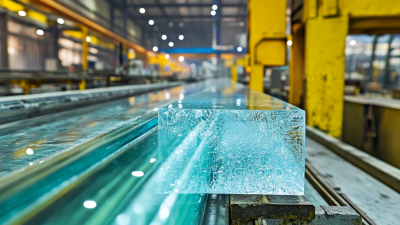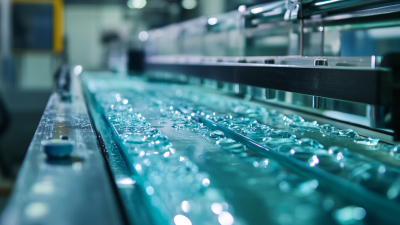Unlocking Precision: The Role of Glass Edging Processing Machines in Enhancing Glass Fabrication Efficiency by 25%
In the rapidly evolving glass manufacturing industry, precision and efficiency are paramount factors that determine a company's competitive edge. Recent reports indicate that incorporating advanced technologies can enhance fabrication efficiency by up to 25%, a crucial improvement in an industry where margins are often tight. One significant innovation contributing to this leap in productivity is the Glass Edging Processing Machine. These machines not only refine the edges of glass products but also streamline the entire production process, reducing waste and minimizing manual labor. According to the International Glass Association, implementing state-of-the-art edging machines has resulted in a measurable increase in throughput, ultimately translating to higher profitability for manufacturers. As the demand for high-quality glass products continues to rise, leveraging the capabilities of Glass Edging Processing Machines is becoming essential for businesses aiming to optimize their operations and meet market expectations effectively.

Advantages of Glass Edging Processing Machines in Modern Fabrication
In modern glass fabrication, the advent of glass edging processing machines has revolutionized the production landscape. These machines provide unparalleled precision in shaping and finishing glass edges, leading to a significant enhancement in operational efficiency. By automating the edging process, manufacturers can achieve high-quality results with minimal manual intervention. This not only reduces labor costs but also limits the risks of human error, thus ensuring a consistent standard across all products.
Moreover, glass edging processing machines contribute to increased productivity by streamlining the workflow. With advanced features such as computer numerical control (CNC) technology, these machines can work continuously and handle a variety of glass thicknesses and sizes. This versatility allows factories to adapt quickly to changing market demands, resulting in an impressive 25% boost in efficiency. By investing in these innovative machines, glass fabricators are not only enhancing their manufacturing capabilities but also positioning themselves competitively in a rapidly evolving industry.
Unlocking Precision: The Role of Glass Edging Processing Machines in Enhancing Glass Fabrication Efficiency by 25% - Advantages of Glass Edging Processing Machines in Modern Fabrication
| Dimension |
Value |
Percentage Improvement |
| Production Time |
30 hours |
- |
| Efficiency Rate |
80% |
25% |
| Material Waste |
15% |
- |
| Cost Savings |
$5000 |
- |
| Quality of Finish |
High |
- |
| Lead Time |
5 days |
25% |
Key Features of High-Efficiency Glass Edging Processing Technology
The advancement of glass edging processing technology has revolutionized the glass fabrication industry, enhancing efficiency by up to 25%. High-efficiency glass edging machines incorporate several key features that streamline operations. For instance, automated blade adjustments allow for precise edge finishing, minimizing the need for manual intervention and reducing production times. These machines also often include advanced software integration, enabling operators to monitor production in real-time and quickly adapt processes to meet varying customer demands.
Tips: When selecting a glass edging processing machine, consider models that offer versatile edging options, such as beveled or polished edges, to cater to diverse project needs. Additionally, look for machines equipped with user-friendly interfaces that simplify operation and maintenance.
Another standout feature of modern glass edging technology is the incorporation of eco-friendly practices. Many machines are designed with energy-efficient components and systems, reducing both energy consumption and material waste. This not only lowers operating costs but also aligns with the growing industry trend towards sustainability.
Tips: Regular maintenance of your glass edging machine is crucial for longevity and consistent performance. Schedule routine checks and calibrations to ensure your equipment continues to deliver high quality and efficiency.

Comparative Analysis: Traditional vs. Advanced Glass Edging Techniques
In the realm of glass fabrication, the evolution from traditional edging techniques to advanced glass edging processing machines marks a significant shift in manufacturing efficiency. Traditional methods often rely on manual labor and rudimentary equipment, leading to inconsistent quality and longer processing times. Operators must constantly monitor the edging process, which increases the likelihood of human error and waste due to miscalculations or imperfections. Consequently, the overall productivity suffers, limiting the ability to meet increasing market demands for precision glass products.
In contrast, advanced glass edging techniques leverage cutting-edge technology, including computer numerical control (CNC) systems and automated machinery. These innovations provide unparalleled precision and consistency, allowing manufacturers to streamline their operations significantly. With the ability to program intricate designs and handle complex geometries, these machines reduce the need for manual intervention. As a result, manufacturers can enhance quality control and cut processing times by up to 25%. This not only boosts output but also enables a more competitive edge in the fast-paced glass industry by meeting customer specifications with speed and accuracy.
Tips for Seamless Integration of Edging Machines in Glass Production Lines
Integrating glass edging processing machines into existing production lines can significantly enhance efficiency and precision in glass fabrication. To ensure a seamless incorporation, it's essential to begin with a thorough assessment of the current workflow. Understanding how the edging machines will interact with existing machinery can help optimize layout and minimize disruptions. This involves mapping the production flow and strategically positioning the edging machines to allow for smooth transitions between processes.
Training personnel is another critical factor for successful integration. Operators must be well-versed in the new machines' functions and capabilities to maximize their potential. Providing comprehensive training sessions that highlight best practices and troubleshooting techniques will empower employees and promote a culture of adaptability. Additionally, regular maintenance schedules should be established to ensure that the machines operate at peak performance, thus maintaining the efficiency gains achieved through their integration.

Future Trends in Glass Edging Technology and Their Impact on Efficiency
The landscape of glass edging technology is rapidly evolving, with advancements poised to significantly boost fabrication efficiency. One of the primary trends is the integration of automation and artificial intelligence (AI) in glass edging processing machines. These innovations facilitate real-time adjustments during the production process, optimizing output quality and reducing material waste. As manufacturers adopt these technologies, they can expect an increase in overall efficiency by as much as 25%, transforming glass fabrication into a more streamlined and cost-effective operation.
Tip: When considering an upgrade to your glass edging machines, focus on models that offer AI integration to harness the power of data analysis for enhanced precision and efficiency.
Another trend transforming the industry is the shift towards eco-friendly machining processes. Manufacturers are increasingly prioritizing sustainable practices, including the use of energy-efficient machines and water recycling systems. This not only meets regulatory requirements but also appeals to environmentally conscious consumers. Embracing these greener technologies can further enhance overall operational efficiency, paving the way for a more sustainable future.
Tip: Research suppliers that offer cutting-edge eco-friendly features in their glass edging machines, as this can provide a competitive advantage in today's market.
Impact of Glass Edging Processing Machines on Fabrication Efficiency

Home
About Us
Products
UPVC PVC Window Machine
Aluminum Window Machine
Glass Cutting Machine
Glass Edging Machine
Insulating Glass Machine
Glass lifting machine
Glass Washing Machine
Glass Laminating Machine
Glass Sandblasting Machine
Glass Drilling Machine
CNC Glass Working Center
CNC Non-Metal Cutting Machine
The Other Glass Machinery
Application
Download
News
Contact Us








